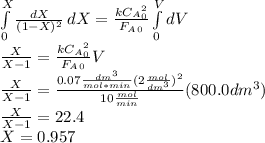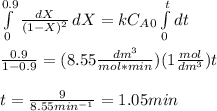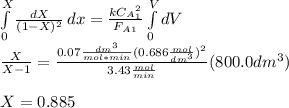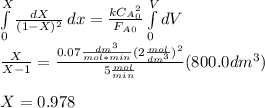
Engineering, 24.03.2020 04:07 rwerjekrryery6750
The liquid-phase reaction follows an elementary rate law and is carried out isothermally in a flow system. The concentrations of the A and B feed streams are 2 M before mixing. The volumetric flow rate of each stream is 5 dm 3 /min, and the entering temperature is 300 K. The streams are mixed immediately before entering. Two reactors are available. One is a gray, 200.0-dm 3 CSTR that can be heated to 77 C or cooled to 0 C, and the other is a white, 800.0-dm 3 PFR operated at 300 K that cannot be heated or cooled but can be painted red or black. Note that k 0.07 dm 3 /mol min at 300 K and E 20 kcal/mol.
a) Which reactor would and what conditions do you recommend? Explaining the reason for your choice. Back up your reasoning with calculations.
b) How long would it take to achieve 90% conversion in a 200 dm3 batch reactor with initial concentrations of A and B at 1 mol/L and operated at 77 °C?
c) What would be your answer to part (b) if at 0 °C?
d) What conversion would be obtained if the CSTR and PFR were operated at 300 K and connected in series? In parallel with 5 dm min of the mixture to each?
e) What can you say about the various reactor types based on the above?

Answers: 3
Another question on Engineering

Engineering, 04.07.2019 18:10
The mass flow rate of the fluid remains constant in all steady flow process. a)- true b)- false
Answers: 1

Engineering, 04.07.2019 18:10
Which one from below is not one of the reasons of planning failures? (clo3) a)-planner is careless. b-planner spend less time in the field but more time on the desk c)-planner is not qualified d)-planner does not have sufficient time to properly plan
Answers: 3

Engineering, 04.07.2019 18:10
An air compression refrigeration system is to have an air pressure of 100 psia in the brine tank and an allowable air temperature increase of 60°f for standard vapor compression cycle temperatures of 77 f entering the expansion cylinder and 14 f entering the compression cylinder, calculate the coefficient of performance a. 2.5 b 3.3 c. 4.0 d. 5.0
Answers: 3

Engineering, 04.07.2019 19:20
Acompressor compresses a gas, a pump compresses a liquid. for a given pressure ratio, why does it take more work to compress a gas in a compressor than a liquid in a pump? a)- for a given pressure ratio the average specific volume for a gas is much higher than the average specific volume for a liquid. b)- there is no difference. the only difference is the amount of heat generated (not work) c)- for a given pressure ratio the average volurge for a gas is much higher than the average volume for a liquid. d)-there is no difference
Answers: 3
You know the right answer?
The liquid-phase reaction follows an elementary rate law and is carried out isothermally in a flow s...
Questions

Mathematics, 13.02.2020 02:28



Mathematics, 13.02.2020 02:28




Health, 13.02.2020 02:28





Mathematics, 13.02.2020 02:38

Chemistry, 13.02.2020 02:39

Mathematics, 13.02.2020 02:39

Biology, 13.02.2020 02:39




Mathematics, 13.02.2020 02:39






![k(T)=k(300K)*exp[\frac{E}{R}(\frac{1}{300K}-\frac{1}{273.15K} )]\\\\k(0^0C=273.15K)=0.07\frac{dm^3}{mol*min} *exp[\frac{20000cal/mol}{1.9872cal/mol*K}(\frac{1}{300K}-\frac{1}{273.15K} )]\\k(0^0C=273.15K)=0.00259\frac{dm^3}{mol*min}\\\\k(77^0C=350.15K)=0.07\frac{dm^3}{mol*min} *exp[\frac{20000cal/mol}{1.9872cal/mol*K}(\frac{1}{300K}-\frac{1}{350.15K} )]\\k(77^0C=350.15K)=8.55\frac{dm^3}{mol*min}](/tpl/images/0560/4913/f56f9.png)







![X_{overall}=\frac{10-[3.43(1-0.885)]}{10} =0.96](/tpl/images/0560/4913/8af0d.png)






